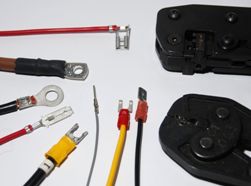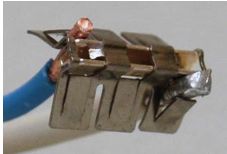Categories: Electrical Reviews
Number of views: 34667
Comments on the article: 1
Stranded wires and their termination
 The manufacture of stranded wires in its process is much more complicated than the manufacture of stranded wires, and requires different manufacturers cable products significantly greater labor and material costs. Accordingly, the cost of stranded wires is higher than stranded wires.
The manufacture of stranded wires in its process is much more complicated than the manufacture of stranded wires, and requires different manufacturers cable products significantly greater labor and material costs. Accordingly, the cost of stranded wires is higher than stranded wires.
Why are stranded conductors needed? The main advantages that they have in comparison with mono-core ones are flexibility and reliability. Especially flexibility stranded cable Valued in electrical switchboard production, where often in confined spaces it is required to mount a large number of wires with numerous bends and even weaves.
The reliability of a multicore cable lies in the fact that when some cores are broken, it continues to fulfill its functions, due to the remaining whole cores.
It should be noted that a prerequisite for the flexibility of the wire is not only the presence of at least several cores, but also their interweaving. And the more the number of wires in the wire, the higher its flexibility class.
The main condition for obtaining high-quality, reliable and safe connections when working with stranded wires is the mandatory termination of any of the types of cable lugs.
It is impossible to find such a contact group in which the fixation of a multicore cable could be carried out without preliminary termination using a ferrule. Rather, in household electrics, the use of multicore wires without termination is still quite common.
The final section of the wire is stripped of insulation and, at best, covered with tinning, and at worst, twisted with fingers. After that, the wire is fixed with a screw or pressure plate, but such a contact cannot be considered reliable and completely safe.
The fact is that a stranded wire is a set of individual cores, which, even when isolated, with external mechanical stress, change their location in relation to each other. And in the stripped section of the wire, under the action of the pressure plate or screw, the cores diverge in different directions, and reliable and durable contact cannot be achieved by definition.
Clamping devices in various contact groups can be conditionally divided into several types, and accordingly, each type can be recommended its own type of cable lugs.
1. The first common type of fixation is the clamping of the wire into the hole of the contact group with the end part of the screw (bolt). This type is used in terminal blocks (terminal blocks), zero tires, pads for extension cords, plugs and sockets, as well as in low-cost sockets.


This fixation option is the worst for a “bare” stranded wire, since the pressure area of the end face of the screw on the wire is very small and in most cases it is much smaller than the diameter of the wire itself. More often than not, the screw simply pushes through that portion of the wire into which it enters, disconnecting the cores and not looking at the tinning. This type of clamp requires the use of lugs, and the best choice for it is tubular lugs (alternative names: sleeve, sleeve cable lugs).

The tubular tip is put on the stripped section of the stranded wire, crimped with a specialized tool, and acts as a sheath for the wire strands, which compresses and holds them together. After that, the wire can be fixed using screws with a small pressure surface.The end part of the screw makes a dent in the sheath of the wire, but does not pierce it, but helps to securely fix the cable in the contact group.
Tubular tips are of three main types: without insulation, with insulation and with insulation for two wires. The first two types differ from each other only in the presence of insulation, and the third type is intended for fixing simultaneously two wires of the declared range, and the cross-sectional ratings are twice as large as those of ordinary tubular tips. Regardless of the type of cable lugs, only a metal sleeve is crimped, and insulation plays an additional function.
2. The second type of fixation is the clamping of the wire with the screw head (bolt). This method is most often used in sockets and switches with old-style mechanisms, some types of terminal blocks, and in switchboard equipment (for connecting wires to various current-carrying surfaces with screws).

It is no secret that in practice, to fix the cable with the screw head, often stranded wires are mounted “naked”. The stripped portion of the wire, at best, is bent around the screw under the cap. Such contact is not safe and reliable.
For this type of clamp, there are two main types of cable lugs - ring and fork.

Ring cable lugs are the best option for fixing with screws (bolts), but the possibility of their use does not always exist. The fact is that the ring tip can be secured with a screw only by putting it on the screw. The latter is feasible in the case when it is possible to completely unscrew the screw from the contact group.
There are contact groups in which access to the screw is limited, and its complete unscrewing is impossible. Fork tips are intended for such groups. In order to connect the fork tip, the screw can only be unscrewed to a height that is only slightly larger than the thickness of the contact part of the tip.
There are two main types of ring and fork tips: with insulation and without insulation. In addition to having insulation, these fork tips are identical to each other.
3. The third type of fixation is currently the most common among the contact groups of the modern sample. This is a clamp using pressure plates of various shapes and sizes.
There are many types of contact groups with such clamps, but they all use the same principle: one clamping device is stationary, and the other moves (using a screw or spring) and presses the stripped portion of the wire to the first plate. This type of fixation is used in most modern electrical and electrical installation products, modular equipment, etc.

For this type of fixation, different types of cable lugs can be used, depending on the device of the contact group. In most cases, for fixing a multicore cable in such contact groups, tubular (sleeve, sleeve) terminals are the best choice, but subject to the use of specialized crimping tools. In this case, the tubular tip can be considered universal, since it is suitable for use with almost all such contacts.
Other types of cable lugs are also possible. For example, contact groups are quite common, in which the pressure screw passes through both pressure plates, dividing the pressure planes into two halves, and, as it were, forming two contact “inputs”.

Fork tips can be used for these contact groups. Unlike other types, fork tips significantly increase the contact area, thereby improving contact and making it more reliable.But it should be said that in the manufacture of jumpers using wires (in cases where a series of “points” are connected in series), the fork tips are not used, since the two contact inputs under the pressure plate each take their own wire.
For those contact groups in which both pressure plates are flat in shape, there is a special type of tip called flat pin (DBV). The contact portion of such a cable lug has a flat shape, and when used with flat pressure plates increases the area and quality of contact.

There are also contact groups in which the inlet has a diameter smaller than the diameter of the wire itself. For such cases, there is a special type of cable lugs called round pin (PTV).
The contact part of such a tip is made in the form of a round pin in cross section and with a diameter smaller than the diameter of the cable. These tips are also known as the “needle”.

4. In modern electrical engineering, there are many different types of electrical products, in which the wire clamp in the contact group is carried out using metal plates. They exert pressure on the wire with their end part (at an oblique angle), which helps to hold the wire in the contact group. The photo shows the inside of one of these terminals.

Such contact groups are initially designed for use only with solid conductors. If it is necessary to use them with a multicore cable, then mandatory use of tubular (sleeve, sleeve) lugs is required.
This article does not apply to power wires and cables and, accordingly, power lugs.
See also at bgv.electricianexp.com
:
